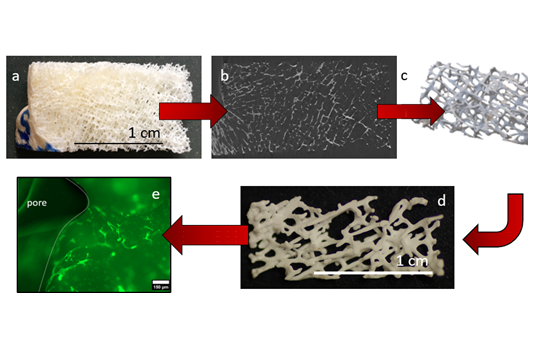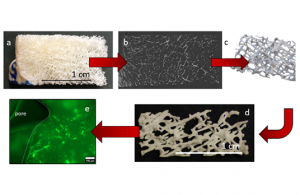
[Publication] 3D hydroxyapatite-based architectures mimicking human trabecular bone: stereolithographic development and in vitro biological evaluation
Hydroxyapatite (HA)-based ceramics are widely used as synthetic bone substitutes. However, designing complex three-dimensional ceramic scaffolds remains a major challenge. The aim of this work, carried out as part of the “Bone Mimicking Ceramic Substitutes (MimOsA)” project involving IRCER and the XLIM and PPRIME Institutes, is to develop a porous ceramic scaffold that mimics natural trabecular bone, and to study its biological behavior.
To achieve this, bone samples, taken at the Centre Hospitalier Universitaire de Limoges in accordance with current ethical rules, were scanned using X-ray microtomography to generate a database of 3D models. From this computer-aided design (.STL files), ceramic scaffolds (HA) were shaped layer by layer by additive manufacturing using stereolithography (SLA). This technique enables the direct manufacture of 3D parts with a controlled porous complex architecture (precision in the order of a hundred microns). The parts were then sintered to obtain dense ceramic scaffolds.
The raw and sintered parts thus obtained were compared respectively with the initial .STL files and the human bone model to be reproduced (wall thickness, size and geometry of the pore network) using image analysis. The optimum machine parameters required to produce these mimetic substitutes were then defined.
Human mesenchymal stem cells (hMSC) were cultured to study the biological properties of these structures (attachment and proliferation of hMSC cells). State-of-the-art characterization tools available on the Biscem platform were used to carry out this cellular study. These preliminary biological assessments demonstrate the good biocompatibility and cell adhesion of these substitutes.
Thanks to this initial proof of concept, work is continuing on the “BELENOS” regional project to functionalize these substitutes (integration of antibiotics, etc.).
 All stages of the MimOsA project: from the creation of the .STL file (c) from collected human bone (a) scanned by X-ray microtomography (b) to the in vitro study (e) of the resulting sintered ceramic part (d).
All stages of the MimOsA project: from the creation of the .STL file (c) from collected human bone (a) scanned by X-ray microtomography (b) to the in vitro study (e) of the resulting sintered ceramic part (d).
About the publication
Journal: Solid State Phenomena (Volume 339)
Pages: 103-108
Article: Processing by Laser Stereolithography and In Vitro Biological Evaluation of Hydroxyapatite Scaffolds Mimicking Human Trabecular Bone Architecture
Auteurs : by Paul Danty, Amandine Magnaudeix, Emeline Renaudie, Fanny Leborgne, Vincent Pateloup, Valery Valle, Eric Champion*, Patricia Pascuad-Mathieu
Lien: https://doi.org/10.4028/p-zn71xt

